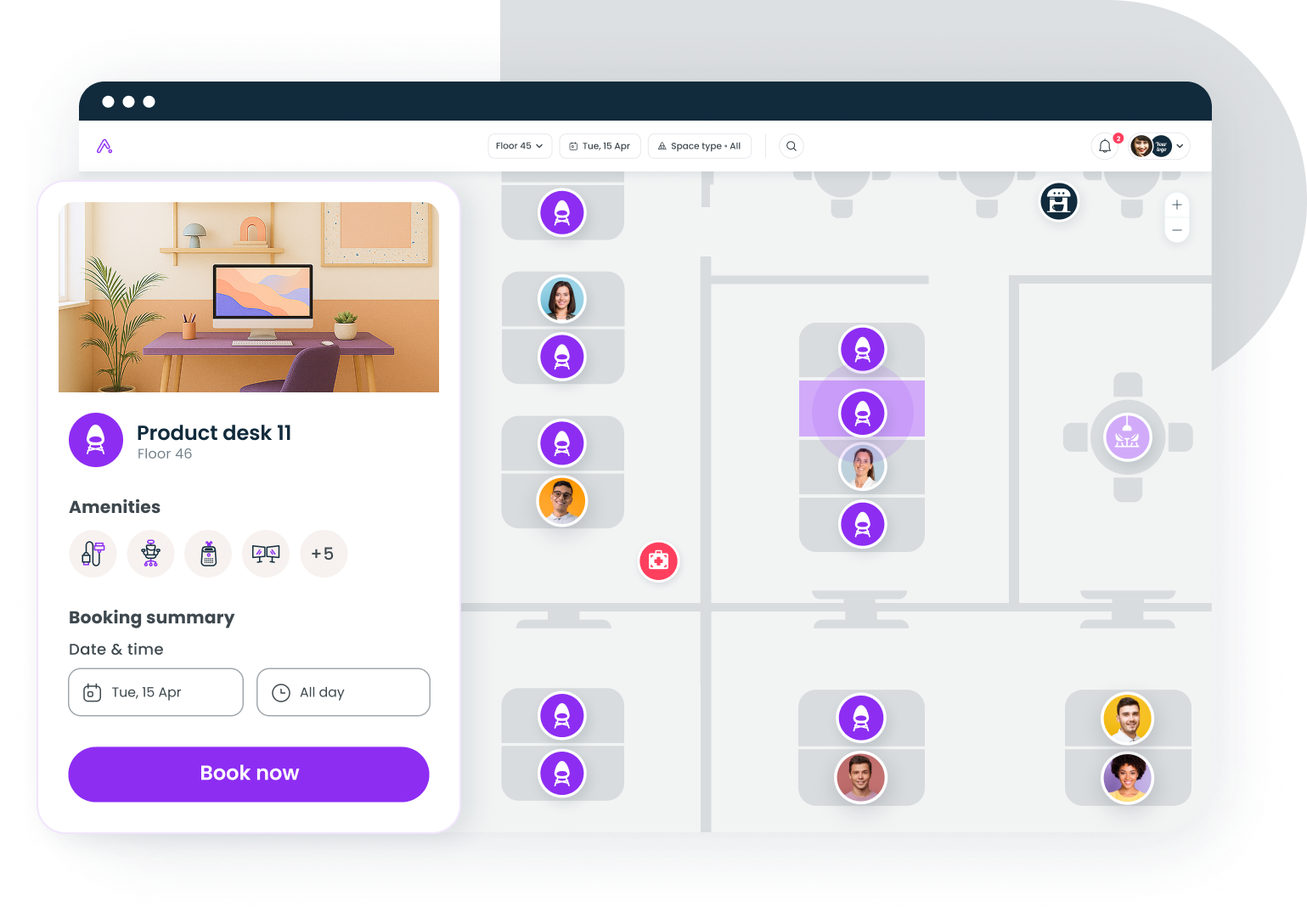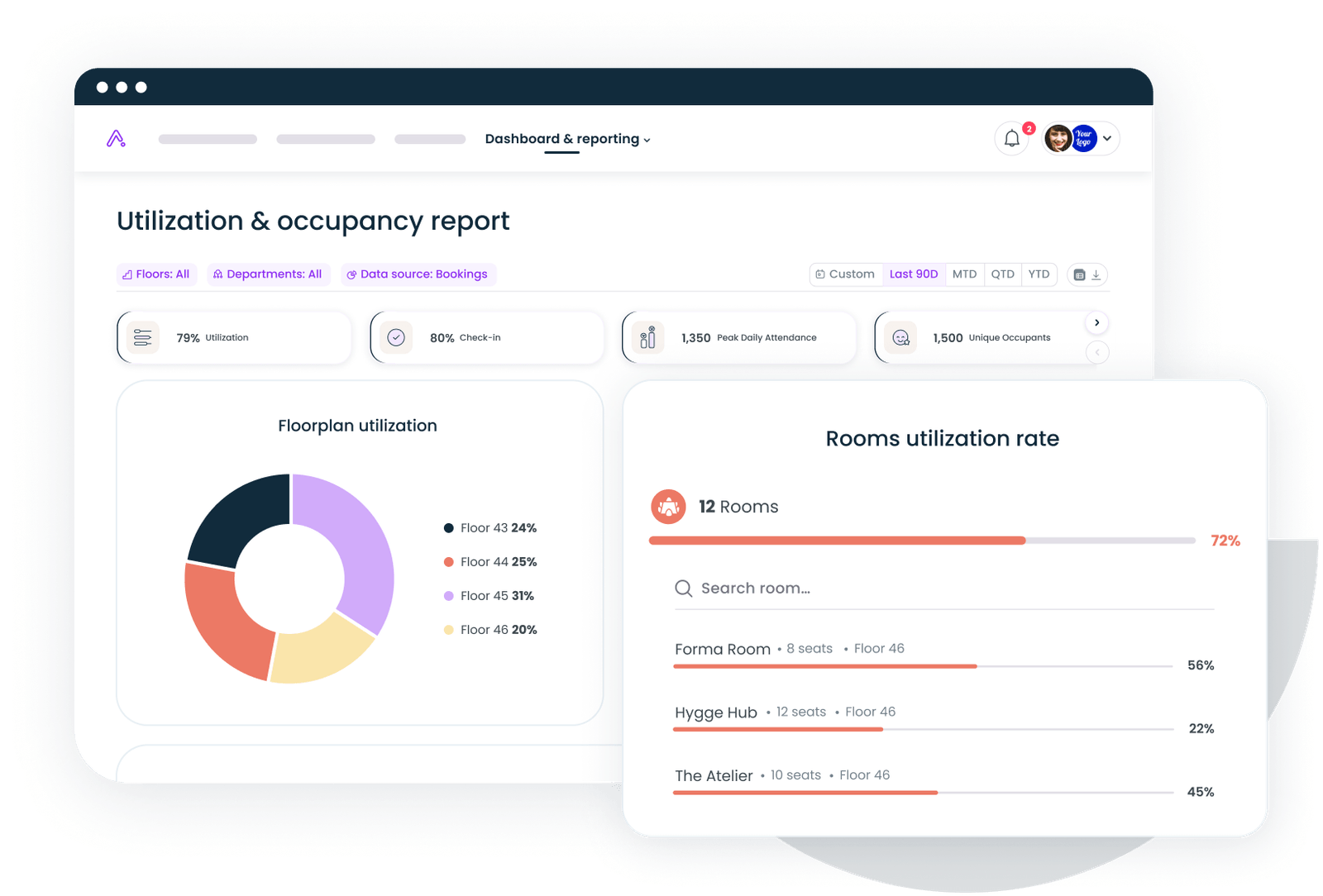The numbers tell the story: offices sit empty 55% of the time, costing companies around $27,000 per desk annually. Meanwhile, demand for office space could drop by 20% in major cities by 2030.
Space management fixes this. It's the process of planning, organizing, and optimizing office space to maximize efficiency and support business objectives. Done right, it cuts costs, boosts productivity, and supports sustainability goals.
What space management actually means
Space management refers to tracking how your office space is used and making data-driven decisions to align your real estate footprint with actual needs. It involves analyzing occupancy patterns, forecasting future space needs, and adapting layouts to changing work patterns.
For facility and space managers, this means having space management tools to monitor usage data, understand employee behavior, and make informed decisions about space allocation. Modern space management solutions provide visibility to turn underutilized spaces into productive environments.
The shift to hybrid work makes this critical. Hybrid employees now spend 46% of their workweek in the office: roughly 2.3 days. Traditional space planning based on assigned desks no longer makes financial sense.
7 key benefits of space management
1. Cut real estate and operating costs
Real estate ranks second only to payroll as the highest expense for most organizations. Nearly 40% of corporate office space sits unused: empty conference rooms, unoccupied desks, and entire floors rarely visited.
Smart space management helps you identify these underutilized spaces through usage data. You can consolidate operations, reduce energy costs, and eliminate unnecessary square footage. Companies report saving up to $11,000 per employee annually by optimizing workspace usage in hybrid models.

Learn practical tips for reducing costs and improving utilization. Our space management guide shows you how to transform underused areas into a productive workspace.
Read the guide
2. Boost employee productivity and satisfaction
Clutter and inflexible space are major workplace distractions. Whether it's overcrowding or excessive isolation, poor office layouts hurt performance.
Effective space management creates environments tailored to different tasks. Quiet zones for focused work. Collaborative spaces for team projects. Flexible spaces that adapt throughout the day. When office employees choose the right environment for their task, they perform better than when confined to assigned desks.
The practical impact? Employees waste up to 30 minutes daily searching for available meeting rooms in poorly managed workplaces. Desk booking software and room scheduling eliminate this inefficiency.
62% of hybrid employees report thriving at work, compared to just 50% of fully on-site workers. Part of this success comes from having flexible office space that supports different work styles.
3. Maximize space utilization
Many organizations have far more wasted space than they realize. Meeting rooms booked but never occupied. Desks reserved but abandoned. Entire neighborhoods sit empty.
Space management solutions with occupancy sensors provide visibility to spot these problems. If usage data shows that certain meeting rooms are consistently unused while others are overbooked, you can reconfigure spaces or adjust policies.
Future space allocation becomes easier with historical data showing trends and patterns. You can forecast future space needs based on actual utilization rates rather than guessing or extrapolating from headcount alone.
4. Support hybrid work effectively
Hybrid space management requires strategies different from those for traditional office management. When you don't know exactly who will be in the office on any given day, you need flexible systems that adapt in real-time.
Desk booking software allows employees to reserve workspaces when they plan to come in, giving facility and space managers visibility into expected occupancy. Team coordination features help employees see where coworkers will be, enabling spontaneous collaboration.
Usage data shows which teams use the office most frequently, what types of spaces they prefer, and when peak demand occurs. This guides decisions about office attendance policies, floor plans, and where to invest in improvements.
5. Enable data-driven workplace strategy
Space management tools provide metrics that matter: occupancy rates by area, peak usage times, booking-to-actual-use ratios, and employee preferences.
Many companies assume large conference rooms are their most valuable asset. But data often reveals these rooms sit empty while smaller huddle spaces for two to four people are consistently overbooked. Rooms designed for 6-9 people average just 2.6 occupants per meeting.
Strategic space management means using this data to make smarter decisions. Instead of adding more large conference rooms, you create the small meeting spaces your teams actually use.
Business operations benefit when workplace data informs real estate decisions. Should you renew that lease? Expand to a second location? Usage data provides the evidence you need.
6. Reduce carbon footprint
Buildings account for one-third of global greenhouse gas emissions and 40% of global energy use. When significant space sits empty, the waste extends beyond financial costs.
$3.36 billion is spent annually on electricity to power, heat, and cool unused office spaces, resulting in 32 billion kilowatt-hours of wasted energy and 22 million metric tons of CO2 emissions.
Efficient space management directly supports sustainability goals. When you reduce energy costs by eliminating underutilized spaces or implementing smart building technology, you're simultaneously cutting emissions. Companies optimizing space utilization report energy consumption reductions of 50% or more.
Give your teams the tools to thrive in hybrid environments. Gable Offices platform provides intuitive desk booking, room scheduling, and real-time space analytics in one place.
Explore Gable Offices
7. Support growth and adaptability
As your business evolves, space needs change. New hires join. Teams reorganize. Work patterns shift. Space management solutions help you strategically plan for growth.
Usage data shows precisely where you have capacity. You might discover that existing office space can accommodate expansion if you eliminate underutilized meeting rooms or reconfigure the floor plan.
Future space allocation becomes more predictable when you track historical patterns. Rather than calculating square footage per employee based on traditional ratios, you can forecast based on how your teams actually use space.
Essential space management components
Realizing the benefits of space requires the right foundation:
Real-time usage data – Occupancy sensors, desk booking systems, and access control integrations provide visibility into how space is used versus how you assume it's used.
Interactive floor plans – Digital tools enable employees to see available space at a glance and reserve what they need quickly.
Flexible booking systems – Desk booking software and conference room scheduling allow employees to reserve office space as needed while giving space managers data about demand patterns.
Analytics and reporting – Space management tools should provide clear metrics on occupancy, utilization, booking patterns, and trends over time.
Integration capabilities – The right tools connect with existing systems—access control for accurate occupancy data, calendar systems for seamless booking, HRIS for employee information.
How to implement space management
Start with an assessment. Understand your current state before making changes. How much office space do you have? What's the current utilization rate? Tools like occupancy sensors provide this baseline.
Define clear goals. Cost reduction? Improved employee satisfaction? Environmental sustainability? Clear objectives guide your space management strategies.
Implement space management tools. Modern solutions provide desk booking software, room scheduling, and analytics. Look for platforms that integrate with existing systems.
Collect and analyze usage data. Let your system gather information for at least a full quarter before making major decisions. This provides enough data to identify patterns.
Involve employees in the process. People who use the space daily have valuable insights, and regular feedback helps you refine your approach.
Make incremental changes. Start with high-impact, low-cost adjustments—reconfiguring underutilized spaces, adjusting booking policies, and adding flexible furniture. Measure results and iterate.
Monitor and adjust continuously. Usage patterns change as your business evolves. Regular reviews ensure your office continues to serve your team's needs efficiently.
Make space management work for your organization
The benefits of space management are clear: reduced costs, improved productivity, better employee experience, and more sustainable operations. But these outcomes require the right combination of strategy, tools, and ongoing attention.
Start by understanding your current space utilization through data, not assumptions. Implement flexible systems that adapt to hybrid work patterns. Involve employees in creating a workplace they actually want to use. And continuously refine your approach based on what the data tells you.
Gable helps you manage desks, rooms, and workplace data in one platform—so you can reduce costs, improve utilization, and create a workplace your teams actually want to use.
Get a demo





.svg)





.svg)
















.svg)












